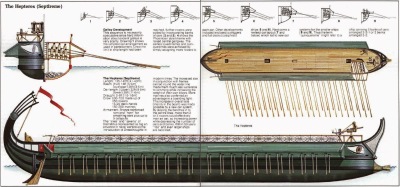The word trireme (Greek trieres) is usually taken to mean a war galley with three banks of oars, superimposed one above another. Representations of galleys with two and three banks of oars have survived; in the fifth century, Athenian rowers were divided into thranitai, zygitai, and thalamitai, according to the tier in which they rowed. The thranitai, who pulled at the longest oars, sometimes received extra pay, as happened at the outset of the Athenian expedition against Syracuse in 415 BC. However, the word trieres contains no allusion to banks of oars; its original meaning may simply have been “triply-furnished”. After the end of the Peloponnesian War, quadriremes and quinqueremes came into general use. Both are mentioned by Arrian in his description of Alexander’s operations at Tyre. In later history, we hear of “ten-furnished”, “twenty-furnished” and even “forty-furnished” galleys. Unless one contemplates a floating skyscraper, it is impossible to suppose that these numbers denoted superimposed banks of oars.
The allusions to “forty-furnished” ships are particularly unconvincing; we may perhaps discount them altogether, but a problem still remains. In a trireme, the rowing benches furnished for anyone triplet of rowers were probably staggered in the fore and aft dimension as well as in cross-section, so that opposite numbers in the upper tiers did not sit directly over the heads of those below. However, even granted such an arrangement, we cannot attribute five banks of oars to a quinquereme without arriving at a top heavy hull. The deployment of the oars themselves would in any case have been complicated and would have presented other problems. Modern scholars, therefore, usually draw the conclusion that a quinquereme was a galley which seated five rowers at one oar, or which shared two or three oars among five rowers. Perhaps the larger denominations take into account rowers on each side of the ship or rowers seated facing each other over a single oar. Those- who make conjectures rely on the analogy of Venetian galleys in medieval and Renaissance times, where practice is known to have varied considerably. One thing seems clear: the ancient classification of war galleys cannot have been consistently by reference to banks of oars.
There is a further implication. If Greek galleys were classified by reference to rowers and not to oars, a single-banked galley furnished with benches for three rowers at each oar should still have qualified for description as a trireme, or triple-furnished ship. The slant of the oars would have meant that the rowers still sat in tiers; those on the inside would still have had the heaviest work, so that the tiers might still have been differentiated as thranitai, zygitai and thalamitai. There is no evidence that this was or was not so. It simply follows logically from what seem necessary assumptions. On the other hand, it is possible that the ancients were not consistent in their use of terms. By the word for a trireme, they may always have meant a galley with three oar banks, even though a quinquereme was not a galley with five oar banks.
Whatever we decide about the quadriremes and quinqueremes that figured so prominently in the navies of Alexander’s Successors, they were bigger and heavier boats; rowed by more men and larger oars. The trireme had been used in battle for ramming or attacking enemy oars and steering gear. It had also served as a platform from which missiles or boarding parties could be launched. The vessels of the late fourth century could in addition carry heavy siege engines on their fore-decks and were capable of towing horse-transport craft.
Demetrius’ navy even featured “fifteen-furnished” and “sixteen furnished” galleys. They were highly spectacular and no doubt had great propaganda value, but do not seem to have been in general use. For many purposes, Demetrius, like any other admiral, was obliged to rely on light, undecked ships, including a “one-and a-half” type of vessel (more literally translated, “a three-halver”). Whether this was supplied with one and a half banks of oars or one and half tiers of rowers remains open to conjecture.
